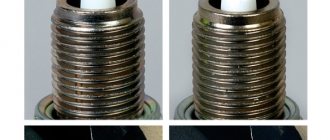Ground clearance Lada Vesta
Lada Vesta on the road
Ground clearance is the most important parameter when choosing any vehicle. The clearance of the Lada Vesta actually competes on equal terms in this attribute with foreign competitors, and sometimes surpasses them.
The release of the new model provoked a lot of talk about what the distance from the bottom of the car to the surface of the earth should be. An overestimated ground clearance of the Lada Vesta can significantly affect the stability of the car, while a lower ground clearance does not allow you to freely overcome bumpy terrain on the road.
↑ Determination of clearance
First, it’s worth understanding what the clearance of the Lada Vesta is. We are talking about ground clearance, that is, the distance from the surface of the earth to the lowest protruding point of the car. Since the vehicle is produced in Russia, the condition of the roads in the country was taken into account during its development. Thanks to this, the car turned out to be quite tall. But it’s worth figuring out what indicators relate to the car.
Ground clearance of Lada Vesta SV Cross - is it suitable for off-road video
Hi all! If anyone is interested, here's the background. I bought my Vesta in November and already upon purchase I resolved the issue with winter tires (GoodYear Ultra grip ice 2, Velcro 205×50xR17 autoreview.ru/articles/shiny/wintertest-r16-2018). During the winter the tires never let me down, I recommend them. Soft, quiet and holds up surprisingly well on ice. I also drove a Ford with Velcro H R2 and Nordman. Subjectively, GoodYear is better. I sold the standard summer tires and decided to switch to “higher” tires in the summer. Why do many people ask the question, because Vesta’s standard wheels are so beautiful and many, on the contrary, take 16k for the winter. My thoughts on this issue: 1. In winter, as a rule, the geography of my movements is reduced. This means less mileage per day and, as a rule, well-known road routes. 2. Are the roads rougher in winter? This is partly true, but winter tires themselves are softer and more comfortable than in summer, plus all the artificial irregularities are ice and snow. They do not have such sharp corners as, for example, holes in the asphalt or curbs. Plus, it’s still softer than aluminum, and in the event of an emergency, the disc is more likely to survive. Look how many people on the NET write about wrinkled standard wheels. 3. In the summer I often travel outside the city to a variety of places and along roads that I see maybe once a year. 4. More speed. 5. Irregularities that are critical for wheels are usually sharp and hard.
↑ Standard ground clearance indicators
If you look at the documents, you can easily understand what ground clearance the Lada Vesta has. It is believed that the distance from the engine crankcase to the ground is 171 mm. If you look at the height from the engine mudguard, the ground clearance will be 144 mm. These measurements were taken on 16-inch wheels. If the car has tires of a different size, then the ground clearance will change. For example, if 15-inch wheels are installed, the distance will be 165 mm to the crankcase and 138 mm to the mudguard.
Three-volume body
Lovers of sedans, of which we have a surprising number, explain their choice by the fact that in a car with a trunk separated from the passenger compartment, it is quieter, warmer and there are no foreign odors coming from the trunk. Each of these statements can be argued. But we can agree. The trunk volume of this sedan is the same as that of the station wagon (under the shelf) - 480 liters, and the rear seat back also folds in parts.
The sedan is also lighter than the station wagon (by 50 kg). And the body is stiffer. This entails better handling. Most likely, the interior will begin to creak later than in the station wagon. However, particularly large items (for example, a packaged washing machine or a kitchen stove) cannot be transported in a sedan. But in a station wagon you can at least try. But this is so, a remark.
↑ Clearance parameters
Above were the ground clearance parameters for the Lada Vesta when loading. As for an empty car, its indicator will be from 171 to 178 mm. There may be higher rates. In general, the manufacturers made sure that the sedan was quite “tall”. Otherwise, it will simply cling to the road with its bottom, which no driver will like. You can measure the distance not only to the crankcase or mudguard. For example, the clearance to the muffler is 18.7 cm.
Increasing lumen in simple words
It is recommended to install spacers. It should be remembered that this operation violates the factory parameters of the chassis. How the suspension will behave and how much such design changes will affect the geometry of the body, including subsequent safety, is unknown.
There are drivers for whom the factory interval sizes do not inspire confidence. There are ways to lift a car. The rear section is raised using a spacer. These are metal plates installed under the struts on top of the spring. Installation by a professional driver takes about half an hour. Due to this method, the gap to the ground increases by three centimeters (cm).
When fixing from the front, difficulties will arise, since the front is heavier and it is inconvenient to crawl up. For this they also buy spacers, but different ones.
Technically, it is possible to increase ground clearance on any car; it is necessary to consider the feasibility of such an undertaking. The easiest way is to install larger diameter tires instead of standard ones. The model under consideration has the ability to install tires with a width from 195 to 215 mm, coupled with replacing discs according to the formula: “lower tires - larger disc diameter, and vice versa,” which is not recommended by the manufacturer. Moreover, installing disks of R16 size is not allowed.
The next option is to replace the standard shock absorber springs. Springs with a larger number of turns are installed. You will also have to change the shock absorbers themselves. This kind of tuning will make the suspension stiffer, but it was a little stiff from the start. The decision is up to the owner; there is no universal recipe.
Such reconstruction is subject to the law on changes in the design of transport; difficulties may arise during the sale. But this is rare.
↑ At full load
The concept of full load implies that the car contains a driver, passengers, and cargo. The sedan can withstand a maximum load of 400 kilograms. This is also reflected at a distance to the surface of the earth. It was already said above that when the car is fully loaded, its value will be 14.4 or 17.1 cm, depending on the location of measurement. It is important to understand that the real ground clearance of the Lada Vesta depends on exactly how loaded the car is. If there is a driver and a passenger in the car, but there is no cargo, then the ground clearance will differ from the declared one.
Technical characteristics of LADA Vesta - body, engine, transmission
The technical characteristics of the LADA Vesta are comparable to similar cars of this class, and here Russian manufacturers decided not to stand out - after all, we are talking about a budget model, so if there are additional modifications, they will be included in the category of a limited series “limited edition”.
Characteristics of the body and transmission of LADA Vesta
The body of the LADA Vesta is much more spacious than its classmates, because its dimensions are located outside the standard B class size classification. It is for this reason that Lada Vesta is classified as subclass B+.
| Name | Class | Length | Width |
| Extra small | A | up to 3.6m | up to 1.6m |
| Small | B | 3.6 – 4.2m | 1.5 – 1.7m |
| Small medium | C | 4.2 – 4.4m | 1.6 – 1.75m |
At the same time, the car is perfectly adapted for the Russian consumer - it has an increased ground clearance of up to 171 mm when fully loaded and a small turning radius of only 5.2 m. Good controllability and responsiveness of the steering wheel are ensured by new characteristics and the layout of the car's transmission - independent front suspension with classic McPherson struts and semi-independent rear suspension on an elastic transverse beam with spaced springs and shock absorbers. As a new feature, the Lada Vesta uses a lower steering rack, which will further increase the information content of the steering wheel. Disc brakes at the front and drum brakes at the rear will be equipped with modern ABS and ESP systems.
Characteristics of the LADA Vesta engine
The Lada Vesta engine line includes three modifications of 1.6-liter power units: 11189 (8-valve, 87 hp), 21129 (16-valve, 106 hp) and HR16 (16-valve ., 114 hp). Moreover, the latest option was developed jointly by members of the Renault-Nissan alliance. It is assumed that an automatic transmission will only be available on the 106 hp engine, although in the future it is possible to expand the available variations. All engines comply with EURO 5 environmental standards and will be actively used in export deliveries of LADA Vesta abroad. Preliminary tests pegged the car's top speed at 185 km/h, with a 0-100 km/h time of just 10.3 seconds, which is pretty good for consumption of 6.9 l/100 km.
In general, the technical characteristics of the Lada Vesta meet the requirements for the car and are designed to provide driving pleasure to an unpretentious driver. I will warn critics against making malicious remarks, the LADA Vesta is a budget car, and you don’t need to demand Ferrari characteristics from it.
| Characteristic | Sedan | Hatchback |
| Curb weight, kg | 1190 | 1150 |
| Length, mm | 4410 | 4250 |
| Width, mm | 1764 | |
| Height, mm | 1497 | |
| Wheelbase, mm | 2635 | |
| Front/rear axle track, mm | 1510 | |
| Turning radius, m | 5,2 | |
| Ground clearance (at full load), mm | 171 mm | |
| Aerodynamic factor, m2 | 0,82 | 0,85 |
| Engines 1.6 l | 11189 (8-valve, 87 hp) 21129 (16-valve, 106 hp) HR16 (16-valve, 114 hp) | |
| Fuel consumption in combined cycle, l | 6,9 | |
| Maximum speed, km/h | 185 | |
| Acceleration time to 100 km/h, sec | 10,3 |
↑ Car behavior on the road
The sufficient height of the car will definitely be appreciated by motorists living in provincial settlements. This is where severe road problems are usually observed. The high ground clearance of the Lada Vesta from AvtoVAZ allows you to minimize the risk of problems associated with this. But the long distance to the bottom also has disadvantages. It negatively affects the vehicle's handling and maneuverability while driving.
Car manufacturers have tried to reduce the negative consequences of high ground clearance. The vehicle has good steering, thanks to which the car behaves well on the road. The reduction in maneuverability is almost imperceptible.
The suspension on the car has also been carefully planned and designed. It rests on the body through a subframe. Thanks to this state of affairs, Vesta has good driving characteristics. Some compare it with foreign cars, and Lada will even give many foreign cars a head start in terms of characteristics. For example, the Nissan Almera has a height to the bottom of 165 mm. The Peugeot 408 has a ground clearance of 178 mm to the crankcase.
If we compare the parameters of Vesta with domestic analogues, then the ground clearance indicator exceeds the characteristics of other models from AvtoVAZ. There are only two cars that have slightly more ground clearance. We are talking about Kalina 2 and Largus with front-wheel drive. This is why Lada Vesta is so popular today. It is liked by drivers who drive a lot on roads that are not of very good quality.
In a word, the ground clearance of the mentioned sedan is a fairly pleasant indicator for drivers. Even at full load the machine remains quite high. This allows you to drive on uneven roads and even overcome all kinds of obstacles without any problems. It is important to understand that if the load is incomplete, the clearance value will differ from that stated in the documents. If you wish, you can take measurements yourself.
Comparison with other domestic options
Vesta's ground clearance up to the stiffener.
Vesta is superior to all of its single-conveyor brothers and sisters . The only exceptions are all-wheel drive models with all-terrain capabilities.
Even they are inferior to our record holder if presented in a hatchback version. The difference is small, but present. It turns out that only Kalina 2 and Largus with all-wheel drive .
The closest import candidates for high ground clearance
A worthy candidate for this class is Nissan Almera , which has a 165 mm distance from the pan to the ground. Just like Vesta on fifteen-inch wheels. But another Datsun on-DO has 174 millimeters , being a record holder in this area.
Even more happens only in those cars that have a higher class. For example, the Peugeot 408 illuminates the road by as much as 178 millimeters from the ground to the crankcase. He sort of set a world record.











